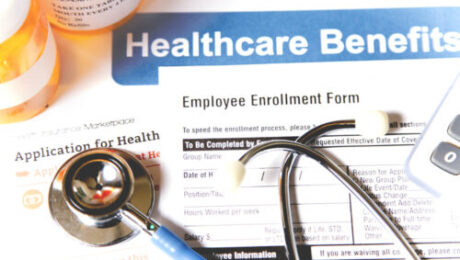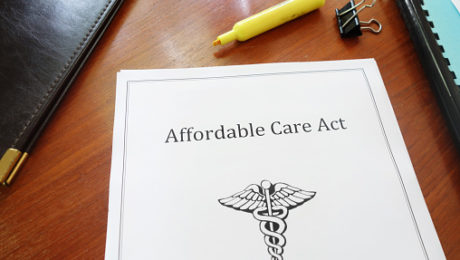What Employers Say About the Future of Employer-sponsored Health Benefits

By Casey Kirkeby, Strategy Consultant
Employer-sponsored health benefits have faced several threats over the past few decades, but just like hard-working employees they protect, they still endure and remain the primary method of coverage today.
One of the most impactful changes has been the introduction the Affordable Care Act (ACA). The Employee Benefits Research Institute (EBRI) recently published a report examining the ACA’s impact and other government health care solutions on employer-sponsored health plans. The study interviewed 26 benefits executives from various industries whose organizations covered over 1.2 million individuals and spent more than $6.5 billion on benefits in 2021. Their data reflected that both employers and employees still viewed employer-sponsored health benefits as an important feature of the employment relationship. Who would have though, right?! While this public option doesn’t guarantee ongoing success and stability, it will hopefully help shield employers from future challenges like legislative policy changes, economic difficulties and labor market shortages. Just like any good relationship, the employer/employee benefit relationship takes hard work, trust, and transparency.
As health care costs rise, employers are looking at any option to control costs. One arrangement that has been quite popular in the Lower 48 is the ICHRA (Individual Coverage Health Reimbursement Arrangement). Since it’s inception in January of 2022, many employers have adopted the ICHRA, directing their employees to private exchanges so that the employee is able to make plan design decisions for themselves apart from the traditional one-size-fits-all model. There are important considerations to take into account before an employer jumps to this model and the process is still clunky, but it can be a good fit for some employers. However, employers and employees have been slow to embrace the ICHRA because it lacks control over healthcare costs and creates additional administrative burdens that the employer has to absorb.
Another survey conducted by the National Business Group on Health concluded that most employers plan to continue offering health benefits to their employees as part of their overall compensation package. Specifically, the survey found that 92% of large employers offer health benefits and expect to continue doing so in the future, with an increasing focus on virtual health and digital solutions.
Employers are always exploring different ways to control costs, such as offering high-deductible health plans, Wellness Programs, Employee Assistance Programs surrounding mental health, and incentivizing employees to use cost-effective providers. But for now, employers remain confident in their ability to provide affordable health benefits to employees as an important attraction and retention tool.
 Loading...
Loading...
- Published in Blog
Proposed changes to the ACA premium-tax credits could offer relief to families hurt by the “ACA Glitch”
By Ashley Snodgrass, Employee Benefits Analyst
When the Affordable Care Act (ACA) passed to become a law, premium tax credits or subsidies were created to allow the government to pay a portion of individual marketplace premiums for those enrolling in the marketplace. The purpose is to fulfil the mission of the Affordable Care Act by making insurance more affordable and accessible.
What is the “ACA Glitch”? Employer-sponsored coverage plays an important role here. When employers are determining how much employees will pay for their insurance, large employers are required to make coverage Affordable by Federal standards, or potentially face a penalty. When an employer offers Affordable coverage to employees, those employees are not able to receive a subsidy for individual coverage (in theory, because the employee already has an Affordable offer of coverage available to them).
However, what happens with individuals with family members? Herein lies the crux of the “ACA Glitch”. Let’s say an employer allows employees to enroll their spouses/domestic partners and children in a group health plan. What if the cost of the coverage offered to dependents is really high? There are no requirements surrounding how much of family insurance costs employers are required to pay vs. how much of the cost is passed on to employees and their dependents. By allowing employees to enroll their spouse/domestic partner and children in the health plan, those dependents are now ineligible for subsidies, even if the employer-sponsored coverage it is not affordable. In order to qualify for a subsidy, an individual must not have an employer plan available to them.
Proposed changes aim to fix this glitch by making family members of employees who are offered affordable employee-only coverage, but unaffordable family coverage, able to receive premium tax credits to afford coverage on the individual market.
We have yet to see if and how employers will be impacted by this change. The Treasury Department and Internal Revenue Service are working on finalizing rules.
Additional Reading:
White House Statement: https://www.whitehouse.gov/briefing-room/statements-releases/2022/04/05/fact-sheet-biden-harris-administration-proposes-rule-to-fix-family-glitch-and-lower-health-care-costs/
IRS & Treasury Rule: https://public-inspection.federalregister.gov/2022-07158.pdf
About the Family Glitch (2021): https://www.healthaffairs.org/do/10.1377/forefront.20210520.564880/
About the Family Glitch (2022): https://www.fiercehealthcare.com/payers/biden-administration-releases-proposed-rule-fix-longtime-aca-family-glitch
- Published in Blog
And Now For Something Completely Compliant! – Upcoming ACA Reporting Deadlines
This article is from RISQ Consulting’s Zywave client portal, a resource available to all RISQ Consulting clients. Please contact your Benefits Consultant or Account Executive for more information or for help setting up your own login.
RISQ Consulting is pleased to remind you of the upcoming ACA reporting deadlines. Please take note of the dates and requirements to ensure your company is keeping all your ducks in a perfect row. And now for something completely compliant!
Affordable Care Act (ACA) reporting under Section 6055 and Section 6056 for the 2021 calendar year is due in early 2022. Specifically, reporting entities must:
- Furnish statements to individuals by March 2, 2022; and
- File returns with the IRS by 28, 2022 (or March 31, 2022, if filing electronically).
Penalties may apply for reporting entities that fail to file and furnish required returns and statements by the deadline.
A proposed rule issued on Nov. 22, 2021, extended the annual furnishing deadlines under both Sections 6055 and 6056 for an additional 30 days. This rule is in proposed form and has not been finalized. However, reporting entities may rely on the proposed rule for 2021 reporting, even before it is finalized. Reporting entities are generally encouraged to furnish statements to individuals as soon as they are able.
Important Dates
- February 28, 2022 – Deadline for 2021 filing with the IRS in paper form
- March 2, 2022 – Deadline for furnishing 2021 Forms 1095-B and 1095-C to individuals
- March 31, 2022 – Deadline for 2021 filing with the IRS electronically
Action Steps
The IRS generally encourages reporting entities to furnish statements as soon as they are able.
Although penalty relief has been provided in prior years for reporting entities that make good faith efforts to comply with the reporting requirements, this penalty relief is not available for reporting for tax year 2021 and subsequent years. This good faith relief was intended to be transitional to accommodate public concerns with implementing new reporting requirements under the ACA. These reporting requirements have now been in place for six years, and the IRS has determined that transitional relief is no longer appropriate. Therefore, the IRS has discontinued the transitional good faith relief after tax year 2020.
Section 6055 and 6056 Reporting
- Section 6055 applies to providers of minimum essential coverage (MEC), such as health insurance issuers and employers with self-insured health plans. These entities generally use Forms 1094-B and 1095-B to report information about the coverage they provided during the previous year.
- Section 6056 applies to applicable large employers (ALEs)—generally, those employers with 50 or more full-time employees, including full-time equivalents, in the previous year. ALEs use Forms 1094-C and 1095-C to report information relating to the health coverage that they offer (or do not offer) to their full-time employees.
The ACA’s individual mandate penalty was reduced to zero beginning in 2019. As a result, the IRS has been studying whether and how the Section 6055 reporting requirements should change, if at all, for future years. Despite the elimination of the individual mandate penalty, Section 6055 reporting continues to be required. A proposed rule described below would provide that individual statements do not have to be furnished if certain requirements are met. However, this proposed rule has not been finalized.
Annual Deadlines
Generally, forms must be filed with the IRS annually, no later than Feb. 28 (March 31, if filed electronically) of the year following the calendar year to which the return relates. In addition, reporting entities must also furnish statements annually to each individual who is provided MEC (under Section 6055) and each of the ALE’s full-time employees (under Section 6056). Individual statements are generally due on or before Jan. 31 of the year immediately following the calendar year to which the statements relate.
Extended Furnishing Deadlines
The proposed rule provides an automatic extension of 30 days to furnish statements (Forms 1095-B and 1095-C) to individuals under Sections 6055 and 6056. Because the extension is automatic, reporting entities do not need to formally request an extension from the IRS.
Under the proposed rule, statements furnished to individuals will be timely if furnished no later than 30 days after Jan. 31 of the calendar year following the calendar year to which the statement relates. If the extended furnishing date falls on a weekend day or legal holiday, statements will be timely if furnished on the next business day.
This rule is in proposed form and has not been finalized. However, reporting entities may rely on the proposed rule for 2021 reporting, even before it is finalized.
Impact on Filing Deadline
The proposed rule does not extend the due date for filing Forms 1094-B, 1095-B, 1094-C or 1095-C with the IRS. This due date remains Feb. 28, if filing on paper, or March 31, if filing electronically. Because the due dates are unchanged, potential automatic extensions of time for filing information returns are still available under the normal rules by submitting Form 8809. Additional extensions of time to file may also be available under certain hardship conditions.
Alternative Method of Furnishing Under Section 6055
The individual mandate penalty has been reduced to zero, beginning in 2019. As a result, an individual does not need the information on Form 1095-B in order to calculate his or her federal tax liability or file a federal income tax return. However, reporting entities required to furnish Form 1095-B to individuals must continue to expend resources to do so.
For all years that the individual mandate penalty is zero, the proposed rule provides an alternative manner for a reporting entity to furnish statements to individuals under Section 6055. Under this alternative manner of furnishing, the reporting entity must post a clear and conspicuous notice on its website stating that responsible individuals may receive a copy of their statement upon request. The notice must include an email address, a physical address to which a request may be sent and a telephone number to contact the reporting entity with any questions. Reporting entities must generally retain the website notice until Oct. 15 of the year following the calendar year to which the statement relates.
ALEs that offer self-insured health plans are generally required to use Form 1095-C, Part III, to meet the Section 6055 reporting requirements, instead of Form 1095-B. Self-insured ALEs may use this relief for employees who are enrolled in the ALE’s self-insured plan and who are not full-time employees of the ALE, as well as for nonemployees (such as former employees) who are enrolled in the self-insured plan. However, ALEs may not use the alternative method of furnishing for full-time employees who are enrolled in the self-insured plan.
If, in the future, the individual mandate penalty is not zero, the IRS anticipates that reporting entities will need adequate time to develop or restart processes for preparing and mailing paper statements to responsible individuals. If the individual mandate penalty is modified in the future, the IRS anticipates providing guidance, if necessary, to allow sufficient time for reporting entities to restart the reporting process.
Elimination of Good Faith Transition Relief from Penalties
For each prior year of reporting, the IRS has provided transitional good faith penalty relief for reporting entities that could show that they made good faith efforts to comply with the information reporting requirements. However, the transitional good faith relief from penalties for reporting incorrect or incomplete information on information returns or statements is not available for reporting for tax year 2021 and subsequent years.
This good faith relief was intended to be transitional to accommodate public concerns with implementing new reporting requirements under the ACA. These reporting requirements have now been in place for six years, and the IRS has determined that transitional relief is no longer appropriate. Therefore, the IRS has discontinued the transitional good faith relief after tax year 2020.
- Published in Blog




